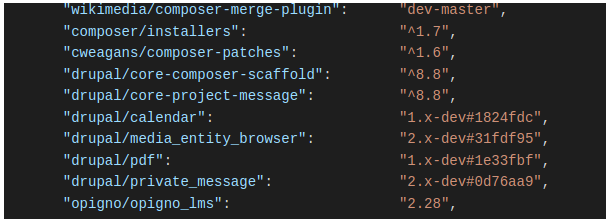Requirement
In case you don't have Composer installed on your server or local machine, you can install it by having a look at: Getting Started on getcomposer.org.
Opigno LMS has the ability to be installed with Composer.
This is the most straightforward way to install Opigno.
To install Opigno LMS with Composer just execute this command:
composer create-project opigno/opigno-composer example-folder
Composer will install in folder 'example-folder' all dependencies required by Opigno LMS.
Upgrade from Opigno LMS 2.x to Opigno LMS 3.x
Updating is possible only from the latest version (at the time of writing this manual it is 8.x-2.28)
The first step is to check hosting environment matches the platform requirements of Drupal 9. The upgrade process is largely related to the transition to D9 and we will check using the Upgrade Status project to check contrib and custom modules compatibility.
While Drupal core does not require Drush, many people do use Drush. Drush will only provide Drupal 9 compatibility in Drush 10.
Make and save a complete dump of your site, files, database, and other important information in a safe place before updating.
Note: Your composer may be different, but below are the common known upgrade paths from Opigno LMS 2.x to Opigno LMS 3.x.
Move the contents of the composer.json file to your directory then delete composer.lock file and run $ composer install
If your version contains many differences from the standard version, which is often the case on projects, use the instructions step by step, which may be preferable. There will also be a list of all changes to the composer file at the end.
1. Install Drush 10.
composer require --dev drush/drush:^10
2. Update a project requirement.
The Opigno LMS 2.x dependency list has been updated to look like this:
if you do not install modules manually, then you can lead to the following form:
and Opigno LMS 3.x will install all the necessary packages for you
3. Repository list
We'll come back to the detailed review of the changes and the repository list, but now we will make a few important changes.
add exclude section and drupal/h5p module. Then add the repository:
The minimum required is ready and now you can run $ composer update.As mentioned earlier you can
Troubleshooting
If this fails with Your requirements could not be resolved…you may need to remove composer.lock and vendor folder. This trick will work if all your modules are installed via composer $ composer install



